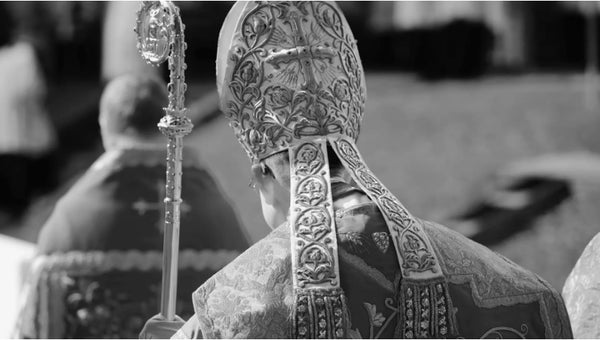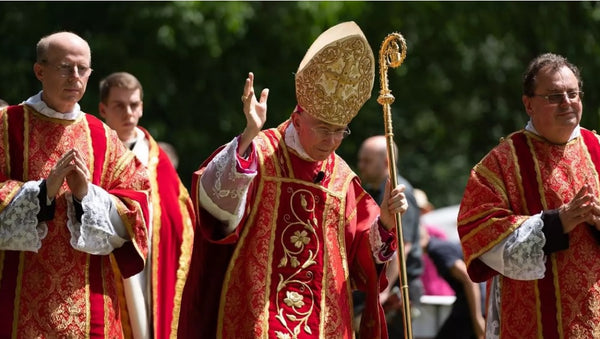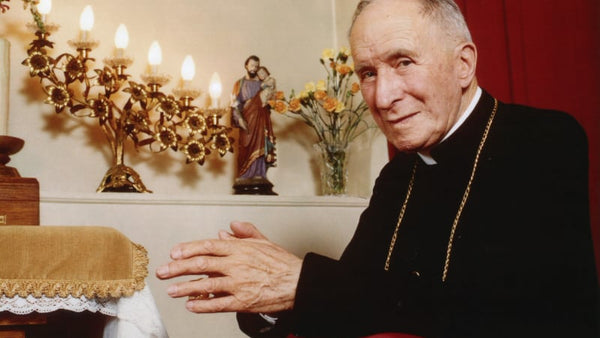Recently-Ordained Priests Gather in Kansas City for Annual Young Priests' Meeting

Archbishop Lefebvre spoke with the young men who thirsted after a priestly formation rooted in the Magisterium of the Church about a plan for a society that he might found so that, once they became priests, they could stay together.
Let us stay united; do not disperse to your modernist dioceses after your ordination! It will be a society of common life, with common residence, prayer and apostolate.
A Setting for Recentering on Community Life
For most in the U.S. District, including most newly ordained priests, the thought of the Regina Coeli House may bring some vague idea of high-browed officials, stacks of paper-work, and a bustling warehouse of ministerial toil. As any visitor will discover though, and in particular every newly ordained priest of the District, it is a refuge of silence, tucked away in the beautiful, wooded hills of Missouri, providing a safe-haven of direction, support, and hospitality to the priests of the District.
Young Priest’s Meeting
Every fall the Regina Coeli House, headquarters of the SSPX U.S. District, hosts all the priests of the two most recently ordained classes assigned to the United States for the annual Young Priests’ Meeting. The meeting provides the newly ordained with the opportunity to communicate freely and directly with their district superiors, receive instruction on pastoral procedures, and, last but not least, the chance to rekindle the fraternal bond that was formed during their time together at the seminary.
Communication and Instruction
Much less than a bustling warehouse with high-browed officials, the young priests are welcomed into a truly familial and hospitable setting. The suitable and beautiful buildings are well-furnished for the guests and bear the essential mark of clerical silence – a breath of fresh air for a priest of the apostolate. The week-long meeting is structured with regular conferences. The conferences cover everything from how to properly oversee the liabilities and assets of a parish’s accounts, to personal planning, priestly holiness, and other pastoral instructions. The priests are given the ample opportunity to speak freely with the full lineup of superiors as well as the legal and accounting team members of the district.
Reunion
Perhaps more precious than practical applications to the individual, comes the chance of reunion at the Young Priests’ Meeting. Back in June, none of them realized at the time that those two minutes standing together in their freshly unfolded chasubles for the post-ceremony picture, just minutes after the conclusion of their Priestly ordination, would be the last time the members of a seminary class would all be in the same place at the same time, perhaps forever. The men who had worked, studied, and prayed elbow to elbow for the last seven years walked away from that spot, and from the place of their formation, not to see each other again for an unknown amount of time. For those assigned to the U.S. District though, that time would be until the Young Priests’ Meeting.
After the first months of their apostolate, they find themselves together again, excitedly exchanging stories and experiences, drawing on the bond of a family that supports as it exists in solidarity. The chance to share a walk and a story with one’s classmate of seminary years after the relative isolation in their priestly work is truly a welcome grace for the young priest; nothing is able to describe the sudden realization that the familiar face he has known eating in that familiar manner across the table for all these years is now essentially different from before: marked with the eternal Priesthood, the same mark on one’s own soul…
In a time of impersonal communication and chains of command, the newly ordained priests of the District are relieved and grateful for the meetings that provide much more than instruction: a communication that is truly paternal, and a source of strength based in the sharing and spirit of the clerical community, all thanks to the foresight of our venerable founder.
sspx.org - 11/09/18
Also in News from Tradition

Death of Bishop Bernard Tissier de Mallerais

Prayer Intention for Bishop Tissier de Mallerais
We ask for prayers for His Excellency Bishop Tissier de Mallerais.
On the morning of Saturday 28 September, after the Angelus, he fell on the stairs of the seminary in Ecône and lost consciousness. He is currently in hospital.

Archbishop Marcel Lefebvre on the Feast of Christ the King
The following sermon for the Feast of Christ the King was delivered by Archbishop Marcel Lefebvre, founder of the Society of Saint Pius X (SSPX), on October 29, 1989 in Dublin, Ireland.
Today we must pray to Our Lord Jesus Christ, we must pray to the Blessed Virgin Mary to remain true Catholics and to do everything possible to become saints. We must come to church frequently, pray in our church, receive the graces of the sacraments in order to become saints, to sanctify our souls and to go to heaven with all the members of our families and all those who kept the Catholic Faith here on earth and now enjoy the happiness of heaven.

Angelus Press
Author